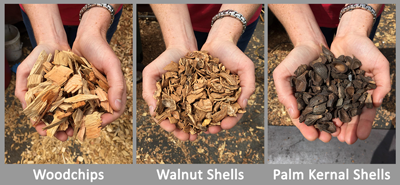For more detailed information about feedstocks for the v.2 reactors in PP20s and PP30s, download the Full Feedstock Section of the Technical Handbook.
For your gasifier to operate properly, you must use the correct biomass fuels which have been properly prepared and sifted.
Feedstock fuel must be dry, of the correct shape and size to flow through the reactor, and free of dust, sand and contaminants:
For Gen2 (v2.x) reactors
- Particle size: 1 cm – 4 cm (0.5 in. – 1.5 in.)
- Moisture content (% by dry weight): 5% – 30%
- Ash content <5%
For Gen3 (v.3.x) swirl-heath tar-cracking reactors
- Particle size: 3mm – 65mm (0.125 in. – 2.5 in.)
- Moisture content (% by dry weight): 15%
- Common wood chipper output should not require sifting
The following Table of Feedstocks shows the most common ones that have been tested and are known to work with Gen2 reactors, which ones are known to be unusable, and which ones need more testing. Final specifications for Gen3 will be released at the time of the Gen3 reactor’s release.
For more information on fuel preparation, contact APL.
Download printable version of this chart
Feedstock Processing and Handling
The v.2 PP30 requires its pieces of feedstock be larger than ½ inch (1cm), but smaller than 1½ inches (4cm), with a moisture content between 10% and 30%. Feedstock that is too big can jam the internal feed system. A max of 10% of the feedstock may be smaller than ½ inch because these small pieces can clog the reactor and prevent the syngas from flowing, as well as causing bridging jams in the hopper.
The v.3 reactor used in the Charpallet CP25 allows 1/8 inch (3mm) particles up to 2½ inches (65mm). The v3 tar cracking reactor does not require the same void space needed for the downdraft gasifier found in v2 reactors, allowing most feedstocks to be used without sifting.
The ideal feedstock has smooth-surfaced chips, such as found on many nut shells, which make the most ideal feedstock. However, most Power Pallet operators use wood chips, even though chips that are very rough can cause fuel jams when the pieces lock together to form bridges rather than flowing.
Chipping
If you intend to use wood chips with the PP30, you will probably want to chip your own with a wood chipper. The two main options are auger chippers and disc chippers. Auger chippers (such as the Laimet brand from Finland) chip to a very regular size depending on the size of the screw auger installed.
While these make very consistent chips, they are much more expensive than the more common disc chippers. While less expensive to purchase, chips from disc chippers need to be sifted to select the right-sized chips, which results in the loss of the feedstock that is either too big or too small. For efficient sifting of large amounts of feedstock, we recommend using a mechanized sifter.
Drying Feedstock
The 5%-30% moisture is measured on a dry-weight basis. Wetter fuel works best at high power levels, because there is more waste heat to dry the feedstock. Moisture levels under 10% can cause too-high temperatures in the reactor, which can fuse the ash and cause clinkers that can clog the reactor.
During start up and wirt Gen3 reactors it’s best to use dryer feedstock (<15% moisture) in the bottom of the hopper and top of the reactor.
The best drying method is to chip green wood and then dry the chips by spreading them out on a tarp or screen and leaving them exposed to the sun and wind. This is because dried wood tends to splinter and form rough pieces which tends to cause bridging and jams. We can supply simple plans to build drying racks that use the radiator exhaust to help speed drying..We aGen2

